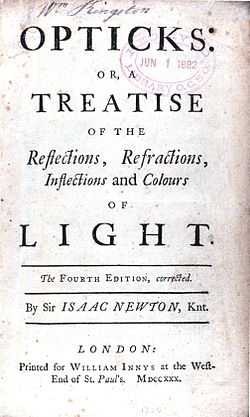- Opticks
-
Opticks is a book written by English physicist Isaac Newton that was released to the public in 1704. It is about optics and the refraction of light, and is considered one of the great works of science in history. Opticks was Newton's second major book on physical science.
Contents
Overview
The publication of Opticks represented a major contribution to science, different from but in some ways rivaling the Principia. Opticks is largely a record of experiments and the deductions made from them, covering a wide range of topics in what was later to be known as physical optics. That is, this work is not a geometric discussion of catoptrics or dioptrics, the traditional subjects of reflection of light by mirrors of different shapes and the exploration of how light is "bent" as it passes from one medium, such as air, into another, such as water or glass. Rather, the Opticks is a study of the nature of light and colour and the various phenomena of diffraction, which Newton called the "inflexion" of light.
In this book Newton sets forth in full his experiments, first reported in 1672, on dispersion, or the separation of light into a spectrum of its component colours. He shows how colours arise from selective absorption, reflection, or transmission of the various component parts of the incident light. His experiments on these subjects and on the problems of diffraction (which he never fully mastered) set the subject of optics on a new level.
Newton's contribution to prismatic dispersion was remarkable since he outlined qualitatively multiple-prism configurations. Multiple-prism arrays, as beam expanders, became central to the design of the tunable laser more than 275 years later thus encouraging the development of the multiple-prism dispersion theory.[1]
Opticks and the Principia
Opticks differs in many aspects from the Principia. First of all, it is written in English rather than Latin. Second, unlike the Principia, it is not presented in a strictly geometric form, with propositions proved by mathematics from either previous propositions or lemmas or first principles (or axioms). It does not prove its propositions by the use of ratios or equations, by the use of fluxions, or the tools of mathematics. Rather, the proofs generally proceed "by Experiments." In many ways, therefore, this work is a vade mecum of the experimenter's art, displaying in many examples the way to make experiments and to draw proper conclusions from them.
The Queries
- See main: The Queries
Opticks concludes with a set of "Queries." In the first edition, these were sixteen such Queries; that number was increased in the Latin edition, published in 1706, and then in the revised English edition, published in 1717/18. The first set of Queries were brief, but the later ones became short essays, filling many pages. In the fourth edition of 1730, there were 31 Queries, and it was the famous "31st Query" that, over the next two hundred years, stimulated a great deal of speculation and development on theories of chemical affinity.
These Queries, especially the later ones, deal with a wide range of physical phenomena, far transcending any narrow interpretation of the subject matter of "optics." They concern the nature and transmission of heat; the possible cause of gravity; electrical phenomena; the nature of chemical action; the way in which God created matter in "the Beginning;" the proper way to do science; and even the ethical conduct of human beings. These Queries are not really questions in the ordinary sense. They are almost all posed in the negative, as rhetorical questions. That is, Newton does not ask whether light "is" or "may be" a "body." Rather, he declares: "Is not Light a Body?" Not only does this form indicate that Newton had an answer, but that it may go on for many pages. Clearly, as Stephen Hales (a firm Newtonian of the early eighteenth century) declared, this was Newton's mode of explaining "by Query."
Other scientists followed Newton's lead. They saw that he had been setting forth a kind of exploratory natural philosophy in which the primary source of knowledge was experiment. This Newtonian tradition of experimental natural philosophy was different from the one based on mathematical deductions. In this sense, Opticks established a kind of Newtonianism that in the eighteenth century rivaled in importance the mathematical natural philosophy of the Principia. Some of the primary adepts in this new philosophy were such prominent figures as Benjamin Franklin, Antoine-Laurent Lavoisier, and James Black.
See also
- Color
- Color theory
- Prism (optics)
- Theory of Colours (book)
- Book of Optics
- Elements of the Philosophy of Newton
- Multiple-prism dispersion theory
References
- ^ F. J. Duarte and J. A. Piper, Dispersion theory of multiple-prism beam expanders for pulsed dye lasers, Opt. Commun. 43, 303–307 (1982).
- Newton, Isaac (1998). Opticks or, a treatise of the reflexions, refractions, inflexions and colours of light : also two treatises of the species and magnitude of curvilinear figures. Commentary by Nicholas Humez (Octavo ed.). Palo Alto, Calif.: Octavo. ISBN 1-891788-04-3.
External links
Full and free online editions of Newton's Opticks
Categories:- 1704 books
- English non-fiction literature
- Books by Isaac Newton
- Optics
- 1704 in science
- Mathematics books
- Physics books
Wikimedia Foundation. 2010.


